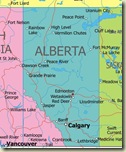We've noted Ontario's interest in nuclear energy and now Alberta  takes a crack at it (courtesy of The Prairie Post):
takes a crack at it (courtesy of The Prairie Post):
The debate about nuclear energy and whether it will have a future in Alberta has officially begun as Bruce Power Alberta begins the planning to build the first nuclear power plant in western Canada and the Alberta government appoints a committee to research whether nuclear energy should be pursued in the province.
That sounds like two stories, doesn't it, since Bruce Power is not going to get very far if the government research goes against it. Here's what Bruce Power has in mind:
Bruce Power, based in Ontario, purchased the assets of Energy Alberta Corporation and in March filed an application with the Canadian Nuclear Safety Commission to prepare a site for the potential construction of the plant on Lac Cardinal near Peace River.
Peace River sounds kind of nice, but Bruce Power! Are all the boys in Canada named Bruce (who are not named Doug, that is)?
And here is what the provincial government is up to:
The [government-selected expert] panel will be asked to provide a comprehensive examination of: environmental, health and safety issues; waste management; comparing nuclear energy with other electricity generation technologies; current and future nuclear power generation being used in Canada and around the world; and Alberta's future electricity needs.
Naturally, writer Rose Sanchez rounds up opposition:
Mary Griffiths, a senior policy analyst with Pembina, says nuclear energy isn't the answer. Instead the greenhouse gas emissions from the oilsands [?] should be dealt with through carbon capture and storage technologies.
Well, that would be good, we guess, if carbon capture and storage technologies were actually ready to be implemented. Curiously, the Pembina Institute sells wind power. Sanchez doesn't mention this, a bit of a journalistic breach - a reporter should come clean when a source might have a financial interest in zinging a competitor.
---
Here's a description of a Pembina Institute book called "Nuclear Power in Canada: An Examination of Risks, Impacts and Sustainability."
In addition to the fact that nuclear power is not itself a [greenhouse gas (GHG)] emission free energy source, a future path based on nuclear energy would simply replace one problem (GHG emissions) with a series of different, but equally unacceptable impacts and risks. These encompass everything from facility reliability and waste management to the potential for catastrophic accidents and nuclear weapons proliferation.
<rant> Feh! This sounds like the building-a-plant-produces-greenhouse-gas thing again plus long discredited arguments. You can download the whole book as a pdf on their site if you want. And hey, Pembina, windmills don't magically erect themselves - we have to assume there's some heavy machinery involved that's less than enviro-friendly. </rant>
---
Ahem! Let's see how what expert panel finds out and wish Bruce Power luck. Alberta seems likely to join the atom club, especially if they lean on the work already done in Ontario and elsewhere to vet nuclear energy.
Thanks to Trails Canada for the map.
Comments
The extraction of oil from the oilsands requires lots of process steam. Right now, that's mostly being produced using gas-fired units. Overall, it makes a lot more economic and environmental sense to produce the steam another way. That's why there's so much interest in nuclear for the oilsands.
On another note, Pembina's costing of nuclear production uses capacity factor and construction cost numbers that are not reasonable in my opinion. However, it's hard to argue with the numbers effectively because Ontario's nukes have (on average) not run that well over their lifetimes, and the costs for building Darlington were huge (mostly due to politically imposed construction delays). Thus, Pembina can always point to Ontario's experience and say "this is the performance/cost scenario that has actually existed."
Ontario has never been the premier operator of CANDUs. When we were setting continuous run records, we were so proud of ourselves... meanwhile, we weren't maintaining the assets properly. Things are better now, but we're still hampered with some old, small, and very complex units... e.g. at Pickering, each 500 MWe unit has 12 steam generators and 16 primary coolant pumps and what seems like *millions* of valves all over the place.